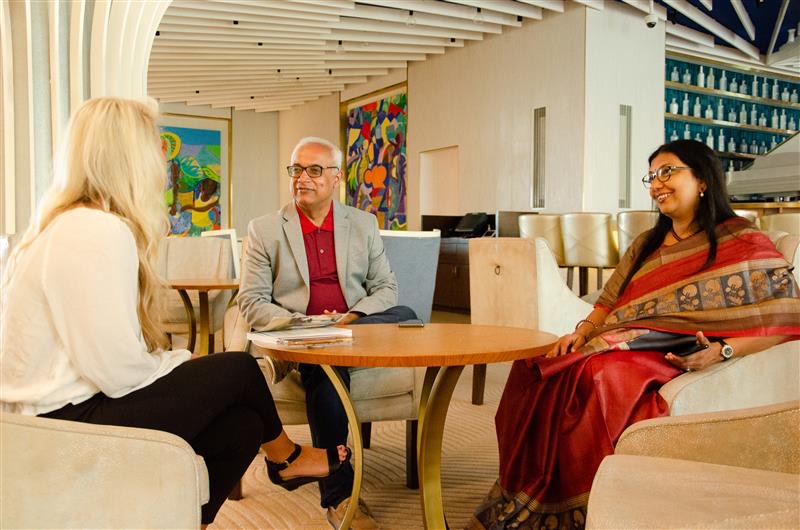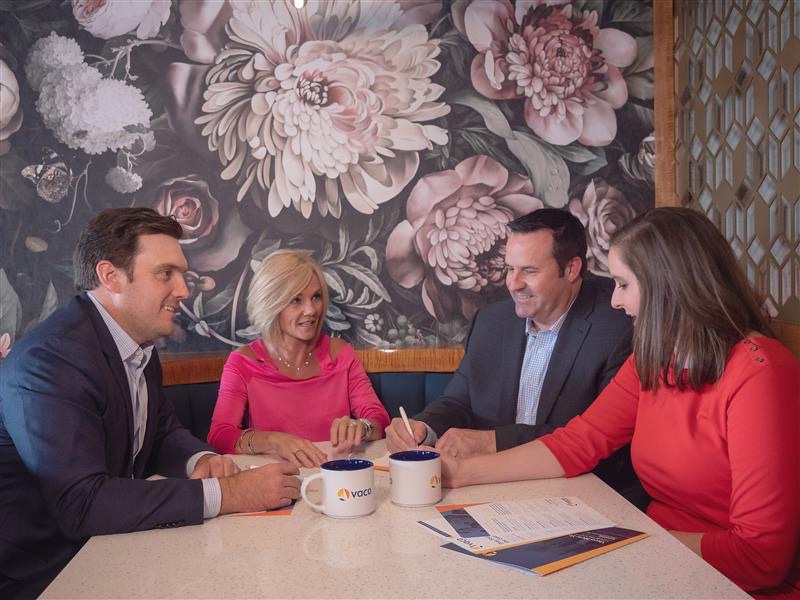Disruption & Adaptation27
Emerging from Crisis by Putting People Above Profits
Stacey Ackerman
June 1, 2020
Stacey Ackerman
June 1, 2020
Having the autonomy to respond to a crisis in a way that puts the people in your community first is what business agility is all about.

When the COVID-19 pandemic hit the world with little warning, forcing everyone to ditch their 2020 business plans, it became a game of survival. While many company’s cultures made it impossible to adapt, those with a strong culture of businoess agility found new opportunities.
For Vaco, a worldwide talent and solutions firm with offices in more than 40 cities in the United States, Europe and India, their entire industry was hit hard. One of its competitors laid off 75 percent of its staff.
The company wasn’t immune from the impacts of the pandemic, and several consultants were furloughed from their assignments, but the company managed to keep all of its offices running and even opened two new offices at a time when most competitors were shutting doors.
Vaco believes its agile culture and putting people first has allowed them not only to weather this storm, but to thrive and find new opportunities when many others in the industry shut their doors, waiting for the storm to pass.
By taking on the ‘people before profits’ approach, your company can also emerge from crisis in a way that’s responsive, adaptable and socially responsible.
Business agility is about an organization’s ability to respond to customers’ needs quickly and with new, innovative ways. The pandemic has been a striking example of companies that had the systems in place to be agile and those that did not.
When Vaco’s Memphis office first learned about the crisis, it’s initial reaction was to reach out to the people who work for them and the local community and ask what kind of support they needed.
“It wasn’t just about Vaco. What keeps us strong in this space is our relationships. Our first question was, How can we support people?” says Bruce Nix, Director of Business Agility & Technical Client Engagement for the Memphis Office.
Vaco has been a sponsor for GiveCamp Memphis / Design for Good, where once a year the company sends professionals for a weekend-long design event that helps nonprofits with a fresh look for websites, databases and marketing materials. Many of the nonprofits hold off on any work for the whole year while they wait for this event to happen because they don’t have the budget to hire talent, even though they have a lot of needs and fresh design may get them needed grant money.

With many professionals being furloughed from their corporate clients’ projects, there was a pool of people looking for meaningful work and a community of nonprofits with a big need.
When the pandemic hit, Vaco reached out to GiveCamp Memphis, as well as its talent pool and just had conversations around what they needed from them right now. From there an idea was born—pair Vaco’s talented professionals who had time on their hands with nonprofits who would greatly benefit from their work.
Vaco is partnering with local nonprofit organizations and pairing them with talented professionals who are willing to donate their time and skills to give back to their community. They are also pairing up small businesses with local professionals; many of whom may have be furloughed due to the onset of COVID-19. With the 1:1 program, for each hour of paid work, these local professionals are donating one hour of their time back to the small business.
Here are a few things your company can do right now to be able to implement this type of emergence from crisis:
During a crisis, responding to people’s basic needs first is critical, and having the business culture to do so is imperative. If your company is caught in the ‘How will we survive?’ paradigm, it’s time to flip that around to ‘How can we help our customers and employees survive?’.
By having this mindset, the Memphis team is able to help nine nonprofits and each organization has one or two consultants working full-time for several weeks. Vaco plans to continue this program as long as there is a need and so far has been able to service everyone.
Vaco has worked hard to keep its talent engaged in meaningful work however possible. In addition, Vaco has partnered with several charitable organizations including animal shelters, a women's shelter, and other local not-for-profit organizations. “People are looking for much more than just punching a clock these days,” says Nix. “The nonprofits are so grateful for any time donated to them, so it’s really rewarding.”
Here are a few ways your company can create a culture that allows you to put people first:
In order to run with this program in the first place, business agility was needed. With Vaco being a large corporation, it would have been natural to centralize management and layer in bureaucracy, but it was the company’s entrepreneurial culture and decentralization that allowed them to ideate and execute quickly.

Each of Vaco’s offices is able to make local level decisions for their market. In Memphis, there are around 30 employees broken into four major divisions. Each of these business units has the freedom to make decisions, as long as they’re aligned to the company’s clearly defined Objectives & Key Results (OKRs).
While the company centralizes their shared services, customer decisions are decentralized so there’s no delay in creating value to customers. “One of the values is around this [entrepreneurial] mindset and we are encouraged to find creative solutions of finding value to clients. There’s autonomy to be able to build and present creative solutions,” says Nix.
If you’re a large corporation, here are a few things you can do to build autonomy:
Customer-centricity is at the heart of agile, and companies that do this well are positioned to thrive during tough times. By leading with empathy, Vaco has become a trusted partner for both its consultants and the businesses and community it serves.
The company entered the crisis by having conversations around people’s basic needs and providing empathy. “They went from being at the top of Maslow’s Hierarchy of Needs to the bottom,” added Nix.
Many staffing firms will fill a role as quickly as it can just to make a quick sale, but Vaco has always had a relationship-based approach since its inception in 2002. “If we had been conditioned by the environment to just place bodies in seats, we’d be facing layoffs and potential office closings,” said Nix.
If you’re looking for ways to lead with empathy, having your company fill out an empathy map for different customers and employees is a great way to start thinking about where they are right now and how your company can respond in a way that meets their immediate needs.
Vaco is a large company, but their leaders are transparent in everything they do, are open to feedback from all levels of the organization and will let you know when they implement that feedback, and recognize ideas from everyone.

“They have entrepreneurial values and principles and don’t let bureaucracy or red tape get in the way of value delivery,” says Nix.
The leaders have always been able to quickly adapt to market fluctuations and have made it through other financial storms throughout the 2000s. With a customer-first mindset, autonomous team structure and an openness to creativity and innovation, Vaco isn’t just talking about business agility—it’s been baked into the culture since day one.
If you’re a company leader, being transparent is a great way to start living and leading through agile values. Make sure everyone at every level knows the company’s response to the crisis, including both its successes and failures.
If people-pleasing and playing it safe is part of your company’s current culture, it’s time to rock the boat! In many organizations, employees are afraid to speak out, and this fear may be getting in your way of some really great, innovative ideas.
At Vaco, speaking up and challenging the status quo is not only accepted, it’s expected. “Outlaws Welcome” is one of their tenets and something they take to heart.
“Vaco’s culture isn’t one where you’ll see a bunch of stiff-collared people,” says Nix. “At this point, you have to welcome the outlaws. We need rebels with a cause,” he says.
Employing people who match the Vaco culture is really important. They only employ people who have a business agility mindset and can challenge the status quo, speak up when something isn’t right, not be afraid to experiment and learn from failure. “Vaco has created an environment where it’s okay to be yourself and authenticity is welcome,” says Nix.
To begin creating this culture at your company, you have to first make sure that people feel psychologically safe. If there has been a history of retaliation for speaking up, people won’t. To gauge where your employees are at in terms of psychological safety, here’s a helpful assessment tool.
When your company experiments creatively, it opens the doors for many new opportunities that you would have never seen coming.
After implementing its partner program with nonprofits, another opportunity was born in the Memphis community, where the Vaco team staffed a call center with 50 people, all of whom had been displaced due to COVID-19. Vaco was able to provide underserved Memphis residents with information on COVID-19 testing and other free resources.
This idea stemmed from an experiment in its Birmingham office, and after the MVP proved successful there, they took some lessons learned and brought the program to Memphis.
The Vaco team working on this project was able to collect a paycheck while providing vital information to the community. “It wasn’t about revenue,” Nix says. “It was about helping the larger community in any way possible.”
To open your doors to new opportunities, use the agile mindset of small experiments that you test and learn from rather than putting all of your time and resources into a large scale idea. Look for a smaller group, location or effort to test your new idea.
Having a business agility culture will allow your organization to respond quickly to customers’ needs both in a crisis and during normal business operations.
A few key takeaways from Vaco’s story that your company can try:
By learning from the Vaco story, you can create a business of agility at your organization. Start small, experiment and learn.
Please subscribe and become a member to access the entire Business Agility Library without restriction.